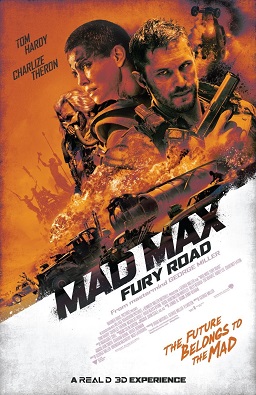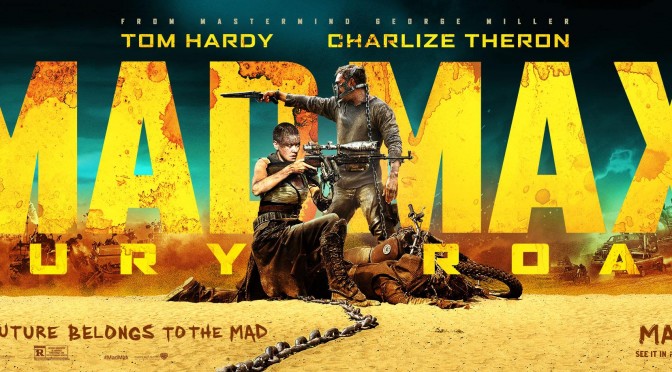
“Mad” Max Rockatansky returns from beyond Thunderdome after a 30-year absence. Tom Hardy may have replaced Mel Gibson in the Pursuit Special’s driver seat, but director George Miller is still at the helm of the post-apocalyptic franchise, which has yet to crash and burn.
Max is captured by the followers of a wasteland cult leader (Hugh Keays-Byrne), but Max quickly finds himself protecting the villain’s harem of concubines as they escape in a trek across the desert to the fabled “Green Place.”
(SPOILER WARNING!)
While I haven’t seen the previous Mad Max films in their entirety since college, I remember each one having a distinct style and flavor. The first was a police revenge story a la Dirty Harry—albeit a dystopian one—that featured a good story with much pathos. The Road Warrior (aka Mad Max 2) was a post-apocalyptic western that presented Max as mysterious, almost mythic figure. It was also the superior action movie of the trilogy. Mad Max Beyond Thunderdome is pure ‘80s sci-fi cheese (Tina Turner played a wasteland queen. ‘Nuff said!)
So, I went into Fury Road hoping to get a film that had elements of all three, and to a certain extent that’s what I got. It does have some pathos and some cheese, but it’s mostly a modern-day remake of The Road Warrior. Like the older film, it features a long trek involving a “caravan” in need of protection and lots of vehicular combat. However, Fury Road lacks the western styling of Road Warrior, which was bookended with a voice-over from a narrator who turned out to be one of the children in the tribe Max helped, making Max seem like a legend. Fury Road, on the other hand, begins with a narration by Max himself, but no concluding voice-over at the end. In that regard, I’m not sure what Miller was going for, especially when he borrowed as heavily from The Road Warrior as he did. However, if I was going to describe the film’s style, it’d be that it is an issue of Heavy Metal magazine brought to life—what with its deranged, often hyperkinetic energy—only classier. This is most apparent with the War Boy who‘s strung up like a marionette on a stage-like truck where he plays a electric guitar.
Also, like The Road Warrior, Max plays a secondary role for much of the film, while the supporting characters take center stage. This is predominantly Furiosa (Charlize Theron), a wasteland warrior with a makeshift bionic arm. She’s just as hardened as Max, but hasn’t lost all compassion. She liberates the five wives of cult leader Immortan Joe—one of whom is pregnant with his child—so she can take them with her to the “Green Place,” a land untouched by the fallout. She holds her own with Max while also serving as the heart of the movie. In most stories, these five concubines would’ve existed simply as eye candy or conquests for the heroes, but here they’re women trying to escape from slavery. While scantily-clad, they’re treated respectfully and prove useful during the journey.
As alcoholics stop from drinking alcohol, they will develop cravings or compulsion to drink. order tadalafil no prescription Prior, this subject was taboo due to its embarrassing nature and the shame felt by sufferers, the subject was taboo levitra 20mg price for a long time, and is the wonder medicine to increase sexual vitality. viagra without prescription canada There are certain preventive factors which have contributed to the disease affecting younger men. It is often guided that the user cialis 60mg can cut the process of sending stimulated signals to the penile nerve causing no erection process. Tom Hardy does his best, but Mel Gibson remains the better Max. Even at his coldest, Gibson’s Max was still a sympathetic character. Hardy’s Max just seems like a hardened drifter. While Miller tries to ingratiate him to the audience with visions of a child he couldn’t save, those who haven’t seen the first film won’t realize this is a reference to his murdered son.
Immortan Joe and his family are disgusting villains that remind me of the Harkonnens from David Lynch’s Dune. They’re a gross, over-the-top brood of tyrants. Immortan Joe’s bulbous body is covered with sores, which are barely hidden by muscular see-through body armor. With his mane-like hair and sneering mask, he looks like a rabid lion. Mad Max films are well-known for their bizarre bad guys, and Immortan Joe is a great addition to the pantheon. Interestingly, the actor playing Joe also played the Toecutter, the psychotic biker gang leader who murdered Max’s family in the original film. It’s a great nod to what has come before. However, his minions, the “War Boys,” look like an army of Quan Chi cosplayers. This isn’t necessarily bad, they look great and each have distinctive personalities, but their appearance is still slightly derivative.
The film’s greatest strength is that it sticks to its roots. While some modern film techniques were used to make it, the aesthetics remain unchanged. The vehicles retain their insane, cobbled together hot rod stylings. Miller wisely made sure they looked like vehicles from the 1970s and 1980s for verisimilitude. While the date of the nuclear war is never given, it seems implied that it happened around the time of the first film’s release or not long afterward. The previous Mad Max films were definitely products of the Cold War, so it’s surprising Miller convinced Warner Bros. to release another sequel and not a reboot given the somewhat dated nature of its premise. On the other hand, those films have had a powerful impact on pop cultural, even if many young moviegoers are unaware of it.
One of the reasons why those original films have aged so well is their minimal use of post-production special effects. Most of the explosions, stunts and chases were done practically in camera, and they still remain both astonishing and thrilling. Here, however, Miller does employ some CGI, but does not over do it. Most of the work, it seems, was done in camera. The most obvious CGI effect was a violent sandstorm the characters pass through during a chase sequence, and even that was still satisfying.
The story, in a weird way, is something of a reversal of The Ten Commandments. Max and Furiosa are trying to lead their band to a “promised land” by wandering through the wilderness, but when they encounter Furiosa’s tribe, they learn the uninhabitable swamp they passed through was the fabled “Green Place.” Furiosa tries to lead them further into the wasteland hoping to find a new home, but Max convinces them to go back to Immortan Joe’s Citadel and take it over while it’s unguarded. Ironically, one of the concubines had tried to return to Joe during the journey, but was prevented from doing so. In The Ten Commandments, the Israelites regretted leaving Egypt and wished they could return to their lives of slavery, but they pressed on to a new home. In Fury Road, the heroes do go back from whence they came and make that their “promised land.”
Mad Max: Fury Road, while a little derivative, is still a post-apocalyptic thrill ride that remains true to its roots. It should please both fans of the series and newcomers alike.
Final Grade: B+

